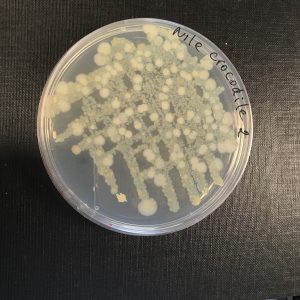This post was contributed by Dr Simon Pooley, Lambert Lecturer in Environment (Applied Herpetology) in Birkbeck’s Department of Geography, Environment and Development Studies

Professor Ward sampling a Nile Crocodile
Adverse encounters between humans and eight species of crocodilians are widespread, from the Americas and the Caribbean, across Africa, Asia and parts of Australia and Oceania. Crocodile attacks, particularly by large animals, are always traumatic and can be fatal or result in permanent disability with devastating personal and social consequences. Most occur in rural areas in developing countries with limited resources for prevention or medical treatment for attack victims. While the initial trauma can prove fatal, as crocodiles have more than 60 teeth and their jaws have tremendous crushing power, many victims survive the attack only to succumb to vicious infections which can result in death or amputations.
Record keeping of attack data has been poor in developing countries, something we are trying to remedy through the online database CrocBITE, developed by Dr Adam Britton and Brandon Sideleau. The medical literature on crocodile attacks is particularly sparse, and a recent survey (Pooley, unpublished) shows that many published papers repeat a small number of research studies, some in obscure journals which are difficult to access. Some microbiological analysis of crocodiles’ mouths and cloaca has been undertaken, most on American alligators (A. mississippiensis), and using now dated techniques. There is some information on infections in bite wounds, but again the literature cites a handful of studies, and little recent microbiological analysis has been undertaken.
 For these reasons I have begun working with Dr John Ward, Professor of Synthetic Biology for Bioprocessing at UCL, on sampling the mouth microbiomes of crocodilians. This study is in its infancy, but in order to see whether crocodiles of various kinds harbour interesting bacteria in their mouths, John and his team have taken samples from captive crocodiles at the UK’s only crocodile zoo, Crocodiles of the World. John’s group will look at both the microorganisms they can culture on agar plates and also the DNA extracted from microbes in the oral cavity of the crocodiles. This DNA can be used to search for genes from microbes that cannot be cultured. This work is in partnership with Prof Helen Hailes, Professor of Chemical Biology at UCL, who with members of her group helped with the sampling.
For these reasons I have begun working with Dr John Ward, Professor of Synthetic Biology for Bioprocessing at UCL, on sampling the mouth microbiomes of crocodilians. This study is in its infancy, but in order to see whether crocodiles of various kinds harbour interesting bacteria in their mouths, John and his team have taken samples from captive crocodiles at the UK’s only crocodile zoo, Crocodiles of the World. John’s group will look at both the microorganisms they can culture on agar plates and also the DNA extracted from microbes in the oral cavity of the crocodiles. This DNA can be used to search for genes from microbes that cannot be cultured. This work is in partnership with Prof Helen Hailes, Professor of Chemical Biology at UCL, who with members of her group helped with the sampling.
We have focussed on crocodiles known to bite humans, notably the Nile crocodile (Crocodilus niloticus) and the saltwater crocodile (C. porosus), but also sampled species representing the full geographical range of crocodilians. Thanks to Shaun Foggett and his keepers Jamie and Terry at Crocodiles of the World, we sampled 12 species including crocodilians from the USA, Central and South America, the Caribbean, Africa, Asia and Australia.
Should John and his team find interesting results, we will develop a proposal to fund an in-depth study using more advanced sampling techniques and identification procedures drawing on his lab’s expertise in epigenetics and bioinformatics. We will work with partners in Australia, the USA, India and Africa to obtain samples from wild crocodiles. In addition to the pure scientific interest of such a study, my primary intention is to discover whether it is bacteria in crocodiles’ mouths that cause the nasty infections we see in crocodile bite wounds on humans. In order to develop an effective treatment protocol, we need to know whether it is just unusual aquatic bacteria, or something peculiar to crocodiles, which we need to treat for. Further, there may be variations between species of crocodilian, or within species across regions (as is the case with snake venom). The next stage will be to medical research partners to study infections in bite wounds, so we can compare these with what I hope John and his team will find.
An additional dimension to this research is discovering how local people in the areas where bites occur respond to bites. My recent research suggests that there are very varied explanations for the causality of crocodile bites across Africa, and treatments for bites and infections may also vary. Working out what is causing infections in crocodile bites, and how we can treat these is a vital step, but convincing local peoples of the efficacy of medical treatments will also be important.
Further reading:
- Pooley, S. 2016. Croc Digest: A bibliography of human-crocodile conflict research and reports
- Pooley, S. 2016. A cultural herpetology of Nile crocodiles in Africa. Conservation and Society, Special issue ‘Conservation, Symbolism and Imagination’, Papers in honour of Brian Morris (in press)
